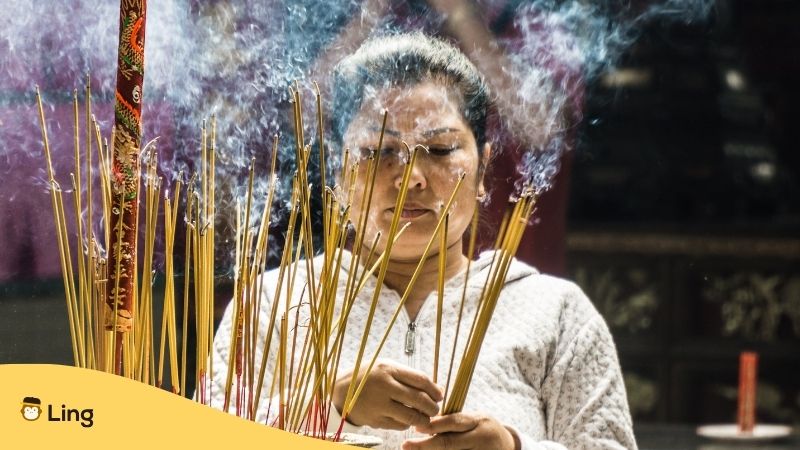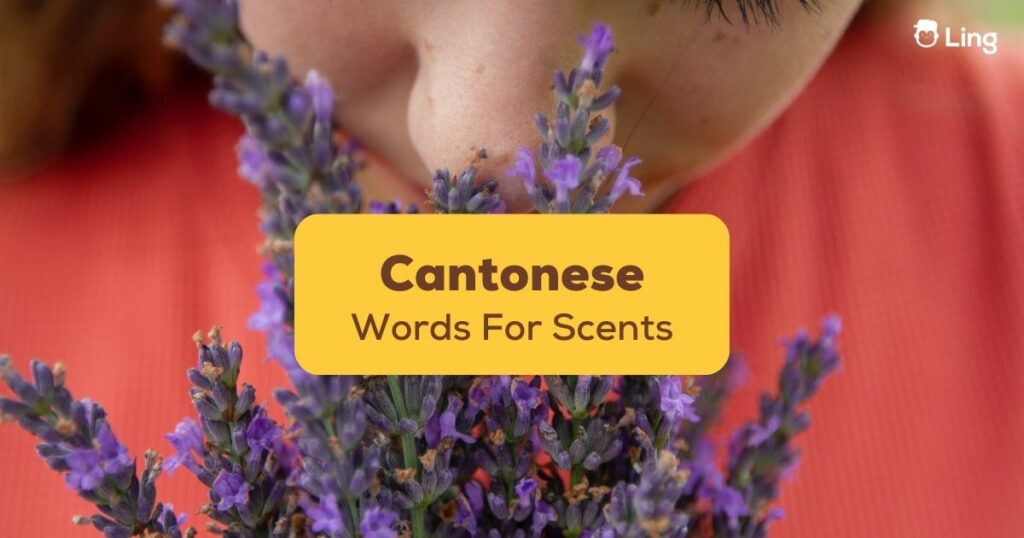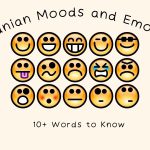Hong Kong is a heady concoction of aromas, whiffs, and smells, and knowing a handful of helpful Cantonese words for scents is essential if you want to distinguish and describe the concoction of odors that make Hong Kong unmistakably Hong Kong.
From the aromatic wafts of street food to the acrid stench of exhaust fumes and the delicate fragrances of flowers, Cantonese captures a vivid spectrum of olfactory experiences. Join me this time for a sensory journey through the Cantonese language, exploring words that beautifully encapsulate the world of scents and smells.
The Foundations: Basic Vocabulary
Before nosing about among the intricacies of Cantonese scent descriptors, let’s establish some base notes with a bit of fundamental vocabulary. These words are essential for anyone interested in understanding how Cantonese speakers perceive and discuss smells:
Fragrance/ Perfume – Hoebg (香)
The word “hoeng” (香) is at the heart of Cantonese olfactory vocabulary. It refers to the concept of fragrance or perfume and serves as a foundational term for discussing smells in general.
Taste/ Flavor /Scent – Mei (味)
The word “mei” (味) is a versatile term that encompasses taste, flavor, and scent. It underscores the close relationship between taste and smell in Cantonese culture.
Smell/ Sniff – Kau (嗅)
When you want to express the act of smelling or sniffing something, you can use the word “kau” (嗅). This verb is especially useful when discussing the action of smelling in context.
Now that we have these basic terms in place, let’s thrust our beaks deeper into Cantonese vocabulary for describing scents and smells.

Fragrant Food Delights
Cantonese cuisine is renowned for its fascinating flavors, and the language reflects this culinary prowess with a plethora of words to describe the scents of various dishes. Here are some mouthwatering examples from the streets of Hong Kong:
Sausage – Hoeng Coeng (香腸)
Cantonese sausages are known for their aromatic blend of flavors, and “香腸” (hoeng coeng) perfectly captures this. The word combines “hoeng” (香) for fragrance and “coeng” (腸) for sausage, painting a vivid picture of a deliciously fragrant food item.
Fragrant And Spicy – Hoeng Laat (香辣)
When a dish combines both fragrance and spice, it’s described as “香辣” (hoeng laat). This term is often associated with dishes that tingle the taste buds and entice the senses.
Fragrant And Crispy – Hoeng Seoi (香脆)
“Crispy” is an essential texture in Cantonese cuisine, and the word “hoeng seoi” (香脆) emphasizes both the texture and aroma of a dish. It’s commonly used to describe foods like deep-fried chicken or succulent spring rolls.
Nature’s Perfumes: Flowers And Plants
Cantonese culture has a deep appreciation for the beauty and fragrance of flowers and plants. The language reflects this love with a range of descriptive words for various scented botanicals:
Fragrant/Aromatic – Fan Fong (芬芳)
The term “fan fong” (芬芳) denotes a delightful and aromatic fragrance. It is often used to sum up the scents of flowers, perfumes, and other pleasant aromas.
Rich And Full-Bodied – Fuk Juk (馥郁)
When a scent is exceptionally rich and full-bodied, Cantonese speakers may use the term “fuk juk” (馥郁). This word is commonly associated with the intoxicating fragrances of blooming flowers.
Herbs – Hoeng Coi (香草)
Herbs play a crucial role in Cantonese cuisine, and “hoeng coi” (香草)” is the term used to refer to these aromatic plants. The refreshing scent of fresh herbs can elevate a dish to new heights.
Capturing The Essence: Descriptive Phrases
Cantonese also employs descriptive phrases to vividly convey the essence of specific scents and smells. These phrases go beyond individual words, offering a holistic sensory experience.
Fragrance Fills The Nose – Hoeng Hei Pok Bei (香氣撲鼻)
This phrase paints a picture of a scent so potent and delightful that it seems to fill one’s entire nasal cavity. It’s often used to describe the irresistible aroma of freshly baked bread or flowers in full bloom.
Aromatic Taste And Scent Fills The Nose – Hoeng Mei Pok Bei (香味撲鼻)
Similar to the previous phrase, “Hoeng Mei Pok Bei” (香味撲鼻) emphasizes both taste and scent, suggesting a dish or aroma that is overwhelmingly delightful.
Fragrance Drifts Ten Miles – Hoeng Piu Sap Lei (香飄十里)
This poetic phrase conveys the idea that a fragrance is so alluring and captivating that it can be detected from a considerable distance. It’s often used to describe the aroma of incense or flowers carried by the wind.

Cantonese Words For Scents: Unique Odor Experiences
Cantonese culture also celebrates unique scent experiences, some of which are deeply rooted in tradition and history:
Longan Fragrance – Lung Ngan Hoeng (龍眼香)
The longan fruit is highly prized in Cantonese cuisine, not only for its sweet and succulent flesh but also for its distinctive fragrance. “Lung ngan hoeng (龍眼香) encapsulates this unique fruity and floral scent that is unmistakably longan.
Agarwood Incense – Cam Hoeng (沉香)
Agarwood, known as “cam hoeng” (沉香), is absolutely everywhere in Cantonese culture as it is used to create fragrant incense and is associated with spiritual and meditative practices and is found burning everywhere from temples to tea shops.
From the mouthwatering fragrances of Cantonese cuisine to the poetic descriptions of blooming flowers and drifting incense, Cantonese Chinese words invite us to explore the olfactory world in all its confusing complexity. So, the next time you are in Hong Kong engage your schnozzle and seek out some spectacular new scents.
Sniff Out More Cantonese With Ling
If you are a beginner wanting to discover more about the delightful Cantonese language or an old hat wishing to add some advanced Cantonese to your word arsenal, Ling app has everything you need. Ling app’s lessons are set by native Cantonese speakers and include plenty of games and quizzes to measure your growing linguistic skills. Why not give Ling app a go today by clicking on the App Store or Google Play?



































































